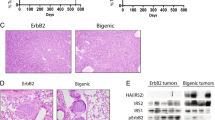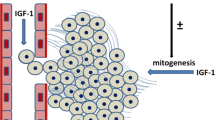Abstract
Insulin-like growth factor binding protein-3 (IGFBP-3) is an important carrier protein for insulin-like growth factors (IGFs) in the circulation. IGFBP-3 antagonizes the growth-promoting and anti-apoptotic activities of IGFs in experimental systems, but in certain contexts can increase IGF bioactivity, probably by increasing its half-life. The goal of this study was to investigate the role of IGFBP-3 in breast carcinogenesis and breast cancer metastasis. In the first part of the study, we exposed IGFBP-3 knockout and wild-type female mice to dimethylbenz[a]anthracene (DMBA) and followed them for appearance of primary tumors for up to 13 months. In the second part, mice of each genotype received an IV injection of 4T1 mammary carcinoma cells and then lung nodules were counted. Our results show that IGFBP-3 knockout mice developed breast tumors significantly earlier than the wild-type (13.9 ± 1.1 versus 22.5 ± 3.3 weeks, respectively, P = 0.0144), suggesting tumor suppression activity of IGFBP-3. In tumors of IGFBP-3 knockout mice, levels of phospho-AKTSer473 were increased compared to wild-type mice. The lung metastasis assay showed significantly more and larger lung nodules in IGFBP-3 knockout mice than in wild-type mice. While we observed increased levels of IGFBP-5 protein in the IGFBP-3 knockout mice, our findings suggest that this was not sufficient to completely compensate for the absence of IGFBP-3. Even though knockout of IGFBP-3 is associated with only a subtle phenotype under control conditions, our results reveal that loss of this gene has measurable effects on breast carcinogenesis and breast cancer metastasis.





Similar content being viewed by others
References
Firth SM, Baxter RC (2002) Cellular actions of the insulin-like growth factor binding proteins. Endocr Rev 23:824–854
Hwa V, Oh Y, Rosenfeld RG (1999) The insulin-like growth factor-binding protein (IGFBP) superfamily. Endocr Rev 20:761–787
Jogie-Brahim S, Feldman D, Oh Y (2009) Unraveling insulin-like growth factor binding protein-3 actions in human disease. Endocr Rev 30(5):417–437
Pollak MN, Schernhammer ES, Hankinson SE (2004) Insulin-like growth factors and neoplasia. Nat Rev Cancer 4(7):505–518
Lu Y, Zi X, Zhao Y, Mascarenhas D, Pollak M (2001) Insulin-like growth factor-I receptor signaling and resistance to trastuzumab (Herceptin). J Natl Cancer Inst 93:1852–1857
Nickerson T, Huynh H, Pollak M (1997) Insulin-like growth factor binding protein-3 induces apoptosis in MCF7 breast cancer cells. Biochem Biophys Res Commun 237:690–693
Pratt S, Pollak M (1994) Insulin-like growth factor binding protein 3 inhibits estrogen-stimulated breast cancer cell proliferation. Biochem Biophys Res Commun 198:292–297
Shen L, Dean NM, Glazer RI (1999) Induction of p53-dependent, insulin-like growth factor-binding protein-3-mediated apoptosis in glioblastoma multiforme cells by a protein kinase Calpha antisense oligonucleotide. Mol Pharmacol 55:396–402
Butt AJ, Williams DC (2001) IGFBP-3 and apoptosis—a licence to kill? Apoptosis 6:199–205
Gill ZP, Perks CM, Newcomb PV, Holly JM (1997) Insulin-like growth factor-binding protein (IGFBP-3) predisposes breast cancer cells to programmed cell death in a non-IGF-dependent manner. J Biol Chem 272:25602–25607
Hong J, Zhang G, Dong F, Rechler MM (2002) Insulin-like growth factor (IGF)-binding protein-3 mutants that do not bind IGF-I or IGF-II stimulate apoptosis in human prostate cancer cells. J Biol Chem 277:10489–10497
McCaig C, Fowler CA, Laurence NJ, Lai T, Savage PB, Holly JMP, Perks CM (2002) Differential interactions between IGFBP-3 and transforming growth factor-beta (TGF-beta) in normal vs cancerous breast epithelial cells. Br J Cancer 86:1963–1969
Williams AC, Collard TJ, Perks CM, Newcomb P, Moorghen M, Holly JMP, Paraskeva C (2000) Increased p53-dependent apoptosis by the insulin-like growth factor binding protein IGFBP-3 in human colonic adenoma-derived cells. Cancer Res 60:22–27
Liu B, Lee KW, Anzo M, Zhang B, Zi X, Tao Y, Shiry L, Pollak M, Lin S, Cohen P (2007) Insulin-like growth factor-binding protein-3 inhibition of prostate cancer growth involves suppression of angiogenesis. Oncogene 26:1811–1819
Gucev ZS, Oh Y, Kelley KM, Rosenfeld RG (1996) Insulin-like growth factor binding protein 3 mediates retinoic acid and transforming growth factor beta 2-induced growth inhibition in human breast cancer cells. Cancer Res 56:1545–1550
Huynh HT, Robitaille G, Turner JD (1991) Establishment of bovine mammary epithelial cells (MAC-T): an in vitro model for bovine lactation. Exp Cell Res 197:191–199
Huynh HT, Yang XF, Pollak M (1996) Estradiol and antiestrogens regulate a growth inhibitory insulin-like growth factor binding protein 3 autocrine loop in human breast cancer cells. J Biol Chem 271:1016–1021
Khandwala HM, McCutcheon IE, Flyvbjerg A, Friend KE (2000) The effects of insulin-like growth factors on tumorigenesis and neoplastic growth. Endocr Rev 21:215–244
Martin JL, Coverley JA, Pattison ST, Baxter RC (1995) Insulin-like growth factor-binding protein-3 production by MCF-7 breast cancer cells: stimulation by retinoic acid and cyclic adenosine monophosphate and differential effects of estradiol. Endocrinology 136:1219–1226
Torrisi R, Parodi S, Fontana V, Pensa F, Casella C, Barreca A, De P, Costa A, Decensi A (1998) Effect of fenretinide on plasma IGF-I and IGFBP-3 in early breast cancer patients. Int J Cancer 76:787–790
Burrows C, Shiry LJ, Holly JMP, Perks CM (2003) Differential effects of IGFBP-3 on apoptosis of breast epithelial cells according to apoptotic trigger. Growth Hormone and IGF Research 13 (Abstract P28):203–222
Fowler CA, Perks CM, Newcomb PV, Savage PB, Farndon JR, Holly JM (2000) Insulin-like growth factor binding protein-3 (IGFBP-3) potentiates paclitaxel-induced apoptosis in human breast cancer cells. Int J Cancer 88:448–453
Neuenschwander S, Schwartz A, Wood TL, Roberts CT Jr, Hennighausen L, LeRoith D (1996) Involution of the lactating mammary gland is inhibited by the IGF system in a transgenic mouse model. J Clin Investig 97(10):2225–2232
Schneider MR, Lahm H, Wu M, Hoeflich A, Wolf E (2000) Transgenic mouse models for studying the functions of insulin-like growth factor-binding proteins. FASEB J 14(5):629–640
Silha JV, Murphy LJ (2002) Insights from insulin-like growth factor binding protein transgenic mice. Endocrinology 143(10):3711–3714
Silha JV, Sheppard PC, Mishra S, Gui Y, Schwartz J, Dodd JG, Murphy LJ (2006) Insulin-like growth factor (IGF) binding protein-3 attenuates prostate tumor growth by IGF-dependent and IGF-independent mechanisms. Endocrinology 147(5):2112–2121
Ning Y, Schuller AG, Bradshaw S, Rotwein P, Ludwig T, Frystyk J, Pintar JE (2006) Diminished growth and enhanced glucose metabolism in triple knockout mice containing mutations of insulin-like growth factor binding protein-3, -4, and -5. Mol Endocrinol 20(9):2173–2186
Mehta HH, Gao Q, Galet C, Paharkova V, Wan J, Said J, Sohn JJ, Lawson G, Cohen P, Cobb LJ, Lee KW (2011) IGFBP-3 is a metastasis suppression gene in prostate cancer. Cancer Res 71(15):5154–5163
Lue Y, Swerdloff R, Liu Q, Mehta H, Hikim AS, Lee KW, Jia Y, Hwang D, Cobb LJ, Cohen P, Wang C (2010) Opposing roles of insulin-like growth factor binding protein 3 and humanin in the regulation of testicular germ cell apoptosis. Endocrinology 151(1):350–357
Aldaz CM, Liao QY, LaBate M, Johnston DA (1996) Medroxyprogesterone acetate accelerates the development and increases the incidence of mouse mammary tumors induced by dimethylbenzanthracene. Carcinogenesis 17(9):2069–2072
Siddiqui RA, Harvey KA, Walker C, Altenburg J, Xu Z, Terry C, Camarillo I, Jones-Hall Y, Mariash C (2013) Characterization of synergistic anti-cancer effects of docosahexaenoic acid and curcumin on DMBA-induced mammary tumorigenesis in mice. BMC Cancer 13:418. doi:10.1186/1471-2407-13-418
Gribben L, Baxter RC, Marsh DJ (2012) Insulin-like growth factor binding protein-3 inhibits migration of endometrial cancer cells. Cancer Lett 317(1):41–48. doi:10.1016/j.canlet.2011.11.011
Chun SY, Chen F, Washburn JG, MacDonald JW, Innes KL, Zhao R, Cruz-Correa MR, Dang LH, Dang DT (2007) CDX2 promotes anchorage-independent growth by transcriptional repression of IGFBP-3. Oncogene 26(32):4725–4729. doi:10.1038/sj.onc.1210258
Saldana SM, Lee HH, Lowery FJ, Khotskaya YB, Xia W, Zhang C, Chang SS, Chou CK, Steeg PS, Yu D, Hung MC (2013) Inhibition of type I insulin-like growth factor receptor signaling attenuates the development of breast cancer brain metastasis. PLoS One 8(9):e73406. doi:10.1371/journal.pone.0073406
Gahete MD, Cordoba-Chacon J, Lantvit DD, Ortega-Salas R, Sanchez-Sanchez R, Perez-Jimenez F, Lopez-Miranda J, Swanson SM, Castano JP, Luque RM, Kineman RD (2014) Elevated GH/IGF-I promotes mammary tumors in high-fat, but not low-fat, fed mice. Carcinogenesis. doi:10.1093/carcin/bgu161
Pollak M, Blouin MJ, Zhang JC, Kopchick JJ (2001) Reduced mammary gland carcinogenesis in transgenic mice expressing a growth hormone antagonist. Br J Cancer 85(3):428–430. doi:10.1054/bjoc.2001.1895
Ramsey MM, Ingram RL, Cashion AB, Ng AH, Cline JM, Parlow AF, Sonntag WE (2002) Growth hormone-deficient dwarf animals are resistant to dimethylbenzanthracine (DMBA)-induced mammary carcinogenesis. Endocrinology 143(10):4139–4142. doi:10.1210/en.2002-220717
Deal C, Ma J, Wilkin F, Paquette J, Rozen F, Ge B, Hudson T, Stampfer M, Pollak M (2001) Novel promoter polymorphism in insulin-like growth factor-binding protein-3: correlation with serum levels and interaction with known regulators. J Clin Endocrinol Metab 86(3):1274–1280
Jernstrom H, Wilkin F, Deal C, Chu W, Tao Y, Majeed N, Narod S, Hudson T, Pollak M (2001) Genetic and non-genetic factors associated with variation of plasma levels of insulin-like growth factor-I and insulin-like growth factor binding protein-3 in healthy premenopausal women. Cancer Epidemiol Biomark Prev 10:377–384
Acknowledgments
We would like to thank Ms. Véronique Michaud and Mr. Yvhans Chery for their technical assistance with the animal care, Dr. Naciba Benlimame and Ms. Lilian Canetti for their collaboration for the immunohistochemistry procedures and Ms Jasmin Sander for the scanning of the slides. We are also grateful to Ms. Rhoda Lim for her help in the submission of this manuscript.
Conflict of interest
Dr. David R. Powell is the Vice-President of Metabolism Research at Lexicon Pharmaceuticals, Inc., of which the knockout mice were generated. The other authors have no conflict of interest to disclose.
Funding
Miguel Bazile was supported through the McGill Integrated Cancer Research Training Program Studentship.
Author information
Authors and Affiliations
Corresponding author
Rights and permissions
About this article
Cite this article
Blouin, MJ., Bazile, M., Birman, E. et al. Germ line knockout of IGFBP-3 reveals influences of the gene on mammary gland neoplasia. Breast Cancer Res Treat 149, 577–585 (2015). https://doi.org/10.1007/s10549-015-3268-8
Received:
Accepted:
Published:
Issue Date:
DOI: https://doi.org/10.1007/s10549-015-3268-8




